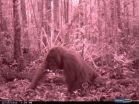(Press-News.org) In addition to their trouble with reading, people with dyslexia also have greater difficulty than typical readers do when it comes to managing competing sensory cues, according to a study reported February 13 in Current Biology, a Cell Press publication. The findings suggest that action video games might improve literacy skills in those with dyslexia, which represent five to ten percent of the population.
"Imagine you are having a conversation with someone when suddenly you hear your name uttered behind you," says Vanessa Harrar of the University of Oxford. "Your attention shifts from the person you are talking to—the visual—to the sound behind you. This is an example of a cross-sensory shift of attention. We found that shifting attention from visual to auditory stimuli is particularly difficult for people who have dyslexia compared to good readers."
In fact, researchers already knew that people with dyslexia had some challenges with auditory processing in addition to their visual impairments. New evidence had also begun to link multisensory integration and dyslexia to the same parts of the brain. That evidence, together with Harrar's own personal challenges with reading and writing, prompted her and her colleagues to conduct one of the first investigations of how people with dyslexia process multisensory stimuli.
Participants in the study were asked to push a button as quickly as possible when they heard a sound, saw a dim flash, or experienced both together. The speed with which they pressed the buttons was recorded and analyzed. While everyone was fastest when the same type of stimuli repeated itself, the data showed that people with dyslexia were particularly slow at pressing the button when a sound-only trial followed a visual-only trial. In other words, they showed "sluggish attention shifting," particularly when asked to shift their attention from a flash of light to a sound.
While the researchers say further study is needed, they suggest based on the findings that dyslexia training programs should take this asymmetry into account.
"We think that people with dyslexia might learn associations between letters and their sounds faster if they first hear the sound and then see the corresponding letter or word," Harrar says. Of course, traditional approaches to reading, in which letters are first seen and then heard, do just the opposite.
Harrar's team goes on to propose a unique, nonverbal approach to improve reading and writing with action video games. "We propose that training people with dyslexia to shift attention quickly from visual to auditory stimuli and back—such as with a video game, where attention is constantly shifting focus—might also improve literacy. Action video games have been shown to improve multitasking skills and might also be beneficial in improving the speed with which people with dyslexia shift attention from one task, or sense, to another."
INFORMATION:
Current Biology, Harrar et al.: "Multisensory integration and attention in developmental dyslexia."
Could action video games help people with dyslexia learn to read?
2014-02-13
ELSE PRESS RELEASES FROM THIS DATE:
Is zinc the missing link for osteoarthritis therapies?
2014-02-13
Osteoarthritis is a leading cause of disability, characterized by the destruction of cartilage tissue in joints, but there is a lack of effective therapies because the underlying molecular causes have been unclear. A study published by Cell Press February 13th in the journal Cell reveals that osteoarthritis-related tissue damage is caused by a molecular pathway that is involved in regulating and responding to zinc levels inside of cartilage cells. A protein called ZIP8 transports zinc inside these cells, setting off a cascade of molecular events that result in the destruction ...
Science is used to reveal masterpiece's true colors
2014-02-13
Scientists are using powerful analytical and imaging tools to study artworks from all ages, delving deep below the surface to reveal the process and materials used by some of the world's greatest artists.
Northwestern University chemist Richard P. Van Duyne, in collaboration with conservation scientists at the Art Institute of Chicago, has been using a scientific method he discovered nearly four decades ago to investigate masterpieces by Pierre-Auguste Renoir, Winslow Homer and Mary Cassatt.
Van Duyne recently identified the chemical components of paint, now partially ...
Conservation science partnership thrives, expands
2014-02-13
For nearly a decade, Northwestern University and the Art Institute of Chicago have been partners in conservation science, unlocking secrets about many of the museum's masterpieces -- by Pierre-Auguste Renoir, Pablo Picasso, Henri Matisse, Winslow Homer, George Seurat, Mary Cassatt and others -- and developing new methods and technologies to investigate art.
Last year, a $2.5 million grant from the Andrew W. Mellon Foundation established the Northwestern University/Art Institute of Chicago Center for Scientific Studies in the Arts (NU-ACCESS), a new national model of ...
Protein switch dictates cellular fate: stem cell or neuron
2014-02-13
Researchers at the University of California, San Diego School of Medicine have discovered that a well-known protein has a new function: It acts in a biological circuit to determine whether an immature neural cell remains in a stem-like state or proceeds to become a functional neuron.
The findings, published in the February 13 online issue of Cell Reports, more fully illuminate a fundamental but still poorly understood cellular act – and may have significant implications for future development of new therapies for specific neurological disorders, including autism and ...
Marriage's 'haves' and 'have nots'
2014-02-13
EVANSTON, Ill. --- Today Americans are looking to their marriages to fulfill different goals than in the past — and although the fulfillment of these goals requires especially large investments of time and energy in the marital relationship, on average Americans are actually making smaller investments in their marital relationship than in the past, according to new research from Northwestern University.
Those conflicting realities don't bode well for the majority of marriages, according to Eli Finkel, professor of psychology in the Weinberg College of Arts and sciences ...
Why did the orangutan come down from the trees?
2014-02-13
Orang-utans come down from the trees and spend more time on the ground than previously realised – but this behaviour may be partly influenced by man, a new study has found.
Dr Mark Harrison, based in the Department of Geography at the University of Leicester and Managing Director of the Orang-utan Tropical Peatland Project (OuTrop) has, along with international colleagues, published results of a seven year study of orang-utans in Borneo in the journal Scientific Reports.
The research, conducted between June 2006 and March 2013, is based on a large-scale analysis of ...
Plants recycle too
2014-02-13
Cells communicate through proteins embedded in their cell membranes. These proteins have diverse functions and can be compared with antennas, switches and gates. For the well-being of the cell, it has to adjust the composition of its membrane proteins and lipids constantly. New proteins are incorporated, while old proteins get recycled or eliminated. The process by which membrane material gets internalized is called endocytosis. A research team headed by Daniël van Damme and Geert De Jaeger from VIB and Ghent University (Belgium), and Staffan Persson from the Max Planck ...
How bacteria communicate with us to build a special relationship
2014-02-13
Communication is vital to any successful relationship. Researchers from the Institute of Food Research and the University of East Anglia have discovered how the beneficial bacteria in our guts communicate with our own cells.
This is a key step in understanding how our bodies maintain a close relationship with the population of gut bacteria that plays crucial roles in maintaining our health, fighting infection and digesting our food.
A study, published in the journal Cell Reports, shows that the gut bacteria produce an enzyme that modifies signalling in cells lining the ...
Broad, MIT researchers reveal structure of key CRISPR complex
2014-02-13
Researchers from the Broad Institute and MIT have teamed up with colleagues from the University of Tokyo to form the first high definition picture of the Cas9 complex – a key part of the CRISPR-Cas system used by scientists as a genome-editing tool to silence genes and probe the biology of cells. Their findings, which are reported this week in Cell, are expected to help researchers refine and further engineer the tool to accelerate genomic research and bring the technology closer to use in the treatment of human genetic disease.
First discovered in bacteria in 1987, CRISPRs ...
Treating stroke with IV magnesium within an hour of symptoms fails to improve outcomes
2014-02-13
In the first study of its kind, a consortium led by UCLA physicians found that giving stroke patients intravenous magnesium within an hour of symptom onset does not improve stroke outcomes, according to research presented today at the American Stroke Association's International Stroke Conference.
However, the eight-year study found that, by working with paramedics in the field, intravenous medications can be given to stroke patients within the "golden hour," the window in which patients have the best chance to survive and avoid debilitating, long-term neurological damage. ...



